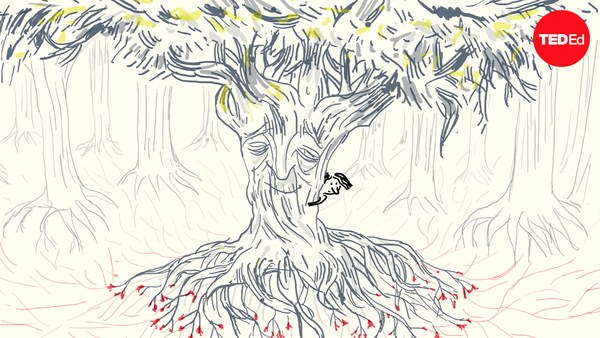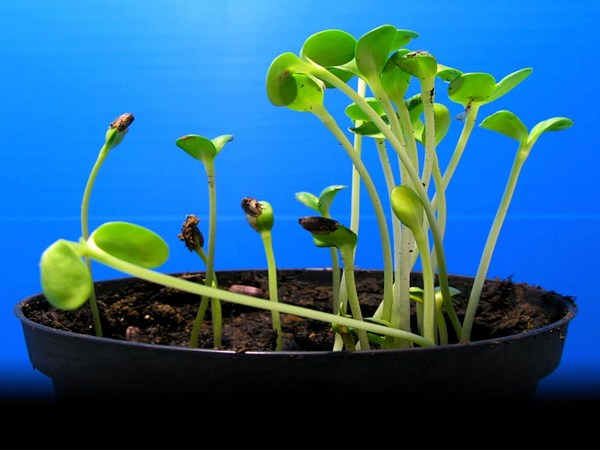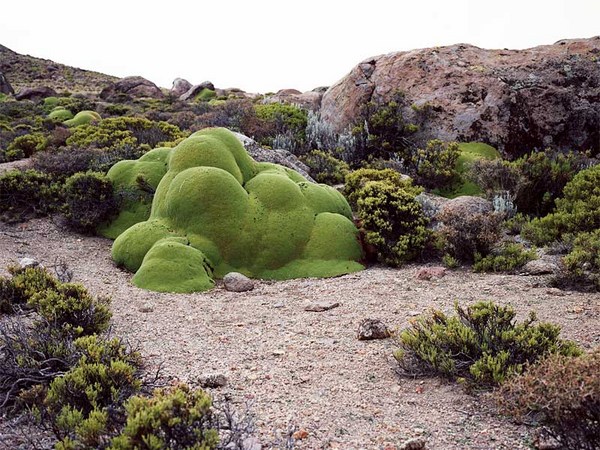So I stand before you as an evolutionary biologist, a professor of evolutionary biology, which sounds like a rather fancy title, if I may say so myself. And I'm going to talk about two topics that aren't normally talked about together, and that's market economies and fungi. Or is it fun-GUY, or, as we say in Europe now, fun-GEE? There's still no consensus on how to say this word.
So I want you to imagine a market economy that's 400 million years old, one that's so ubiquitous that it operates in almost every ecosystem of the world, so huge that it can connect millions of traders simultaneously, and so persistent that it survived mass extinctions. It's here, right now, under our feet. You just can't see it. And unlike human economies that rely on cognition to make decisions, traders in this market, they beg, borrow, steal, cheat, all in the absence of thought.
So hidden from our eyes, plant roots are colonized by a fungus called arbuscule mycorrhizae. Now the fungus forms these complex networks underground of fine filaments thinner than even threads of cotton. So follow one of these fungi, and it connects multiple plants simultaneously. You can think of it as an underground subway system, where each root is a station, where resources are loaded and unloaded. And it's also very dense, so roughly the length of many meters, even a kilometer, in a single gram of dirt. So that's the length of 10 football fields in just a thimbleful of soil. And it's everywhere. So if you passed over a tree, a shrub, a vine, even a tiny weed, you passed over a mycorrhizal network. Roughly 80 percent of all plant species are associated with these mycorrhizal fungi.
So what does a root covered in fungi have to do with our global economy? And why as an evolutionary biologist have I spent the last 10 years of my life learning economic jargon? Well, the first thing you need to understand is that trade deals made by plant and fungal partners are surprisingly similar to those made by us, but perhaps even more strategic. You see, plant and fungal partners, they're not exchanging stocks and bonds, they're exchanging essential resources, and for the fungus, that's sugars and fats. It gets all of its carbon directly from the plant partner. So much carbon, so every year, roughly five billion tons of carbon from plants go into this network underground. For the root, what they need is phosphorus and nitrogen, so by exchanging their carbon they get access to all of the nutrients collected by that fungal network. So to make the trade, the fungus penetrates into the root cell of the host and forms a tiny structure called an arbuscule, which is Latin for "little tree." Now, you can think of this as the physical stock exchange of the trade market.
So up until now, it seems very harmonious. Right? I scratch your back, you scratch mine, both partners get what they need. But here is where we need to pause and understand the power of evolution and natural selection. You see, there's no room for amateur traders on this market. Making the right trade strategy determines who lives and who dies.
Now, I use the word strategy, but of course plant and fungi, they don't have brains. They're making these exchanges in the absence of anything that we would consider as thought. But, as scientists, we use behavioral terms such as strategy to describe behaviors to certain conditions, actions and reactions that are actually programmed into the DNA of the organism.
So I started studying these trade strategies when I was 19 years old and I was living in the tropical rainforests of Panama. Now, everybody at the time was interested in this incredible diversity aboveground. And it was hyperdiversity. These are tropical rainforests. But I was interested in the complexity belowground. We knew that the networks existed, and we knew they were important, and I'm going to say it again, by important I mean important, so the basis of all plant nutrition for all the diversity that you do see aboveground. But at the time, we didn't know how these networks worked. We didn't know how they functioned. Why did only certain plants interact with certain fungi? So fast-forward to when I started my own group, and we really began to play with this trade market. You see, we would manipulate conditions. We would create a good trading partner by growing a plant in the sun and a poor trading partner by growing it in the shade. We would then connect these with a fungal network. And we found that the fungi were consistently good at discriminating among good and bad trading partners. They would allocate more resources to the host plant giving them more carbon.
Now, we would run the reciprocal experiments where we would inoculate a host plant with good and bad fungi, and they were also good at discriminating between these trade partners. So what you have there is the perfect conditions for a market to emerge. It's a simple market, but it's a market nonetheless, where the better trading partner is consistently favored.
But is it a fair market? Now this is where you need to understand that, like humans, plants and fungi are incredibly opportunistic. There's evidence that the fungus, once it penetrates into the plant cell, it can actually hijack the plant's own nutrient uptake system. It does this by suppressing the plant's own ability to take up nutrients from the soil. So this creates a dependency of the plant on the fungus. It's a false addiction, of sorts, whereby the plant has to feed the fungus just to get access to the resources right around its own root. There's also evidence that the fungi are good at inflating the price of nutrients. They do this by extracting the nutrients from the soil, but then rather than trading them with the host, they hoard them in their network, so this makes them unavailable to the plant and other competing fungi. So basic economics, as resource availability goes down, the value goes up. The plant is forced to pay more for the same amount of resources.
But it's not all in favor of the fungus. Plants can be extremely cunning as well. There are some orchids -- and I always think orchids somehow seem like the most devious of the plant species in the world -- and there are some orchids that just tap directly into the network and steal all their carbon. So these orchids, they don't even make green leaves to photosynthesize. They're just white. So rather than photosynthesizing, tap into the network, steal the carbon and give nothing in return.
Now I think it's fair to say that these types of parasites also flourish in our human markets. So as we began to decode these strategies, we learned some lessons. And the first one was that there's no altruism in this system. There's no trade favors. We don't see strong evidence of the fungus helping dying or struggling plants unless it directly benefits the fungus itself.
Now I'm not saying if this is good or bad. Unlike humans, a fungus, of course, cannot judge its own morality. And as a biologist, I'm not advocating for these types of ruthless neoliberal market dynamics enacted by the fungi. But the trade system, it provides us with a benchmark to study what an economy looks like when it's been shaped by natural selection for hundreds of millions of years in the absence of morality, when strategies are just based on the gathering and processing of information, uncontaminated by cognition: no jealousy, no spite, but no hope, no joy.
So we've made progress in decoding the most basic trade principles at this point, but as scientists we always want to take it one step further, and we're interested in more complex economic dilemmas. And specifically we're interested in the effects of inequality.
So inequality has really become a defining feature of today's economic landscape. But the challenges of inequality are not unique to the human world. I think as humans we tend to think that everything's unique to us, but organisms in nature must face relentless variation in their access to resources.
How does a fungus that can again be meters long change its trade strategy when it's exposed simultaneously to a rich patch and a poor patch? And, more generally, how do organisms in nature use trade to their advantage when they're faced with uncertainty in terms of their access to resources?
Here's where I have to let you in on a secret: studying trade underground is incredibly difficult. You can't see where or when important trade deals take place. So our group helped pioneer a method, a technology, whereby we could tag nutrients with nanoparticles, fluorescing nanoparticles called quantum dots. What the quantum dots allow us to do is actually light up the nutrients so we can visually track their movements across the fungal network and into the host root. So this allows us finally to see the unseen, so we can study how fungi bargain at a small scale with their plant hosts. So to study inequality, we exposed a fungal network to these varying concentrations of fluorescing phosphorus, mimicking patches of abundance and scarcity across this artificial landscape. We then carefully quantified fungal trade. And we found two things.
The first thing we found was that inequality encouraged the fungus to trade more. So I can use the word "encouraged" or "stimulated" or "forced," but the bottom line is that compared to control conditions, inequality was associated with higher levels of trade. This is important, because it suggests that evolving a trade partnership in nature can help organisms cope with the uncertainty of accessing resources.
Second, we found that, exposed to inequality, the fungus would move resources from the rich patch of the network, actively transport them to the poor side of the network. Now, of course, we could see this because the patches were fluorescing in different colors. So at first, this result was incredibly puzzling. Was it to help the poor side of the network? No. We found that the fungus gained more by first moving the resources to where demand was higher. Simply by changing where across the network the fungus was trading, it could manipulate the value of those resources.
Now this stimulated us to really dig deeper into how information is shared. It suggests a high level of sophistication, or at least a medium level of sophistication in an organism with no cognition. How is it that a fungus can sense market conditions across its network and then make calculations of where and when to trade? So we wanted to look about information and how it's shared across this network, how the fungus integrates cues.
So to do that, what you need to do is dive deep in and get a higher resolution into the network itself. We began to study complex flows inside the hyphal network. So what you're looking at right now is a living fungal network with the cellular contents moving across it. This is happening in real time, so you can see the time stamp up there. So this is happening right now. This video isn't sped up. This is what is happening under our feet right now. And there's a couple of things that I want you to notice. It speeds up, it slows down, it switches directions.
So we're working now with biophysicists to try to dissect this complexity. How is the fungus using these complex flow patterns to share and process information and make these trade decisions? Are fungi better at making trade calculations than us?
Now here's where we can potentially borrow models from nature. We're increasingly reliant on computer algorithms to make us profitable trades in split-second time scales. But computer algorithms and fungi, they both operate in similar, uncognitive ways. The fungi just happens to be a living machine.
What would happen if we compare and compete the trading strategies of these two? Who would win? The tiny capitalist that's been around since before and the fall of the dinosaurs?
My money is on the fungus.
Thank you.
(Applause)





